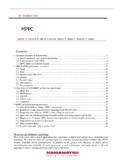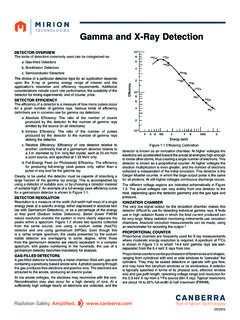Transcription of Silicon Photomultiplier - Hamamatsu Photonics
1 Silicon PhotomultiplierSlawomir PiatekTechnical Consultant, Hamamatsu , Performance & Possible ApplicationsIntroductionVery high intrinsic gain together with minimal excess noise make Silicon Photomultiplier (SiPM) a possible choice of a photodetector in those applications where the input light is in the photon-counting range. 2 IntroductionThis webinar is a high-level review of SiPM s structure, operation, and opto-electronic characteristics, followed by a discussion of some possible applications. 3 Outline Structure and operation Opto-electronic characteristics Applications +Automotive ToF LiDAR +Flow cytometry +Radiation detection and monitoring Summary and conclusions 4 SiPMStructure and Operation of a SiPMPortraits of SiPMs (images not to scale)5 SiPM structureSiPM is an array of microcells=APDRQp+ n+p+oxideSingle microcellelectrical equivalent circuit of a microcellSide viewTop view6 SiPM microcellRQAPDAll of the microcells are connected in parallel 7 SiPM specificationsActive area: 6 6 mm2 Microcell size (pitch): 10 10, 15 15, 25 25, 50 50, 75 75 m2 Number of microcells.
2 (active area)/(microcell size), from 100 s to 10,000 s Overvoltage: V = VBIAS VBD;recommended by the manufacturer8 SiPM operationVBIAS> VBDKA GRLtime [ns]Amplitude [mV]Example of single-photoelectron waveform (1 ) Gain = area under the curve in electrons 9 SiPM operationtime [ns]Amplitude [mV]Fast componentSlow componentRC time constant of the slow component depends on microcell size (all else being equal)Recovery time tR 5 times the RC time constanttRis on the order of 10 s to 100 s ns but in practical situations, it is also a function of detection bandwidth 10 SiPM output of an SiPM is a chronological superposition of current pulsesCurrent pulses due to photonsSiPM also outputs current pulses even in absence of light.
3 Dark counts (dark current)11 Dark pulses are indistinguishable from those due to photonsThe rate of dark counts depends on overvoltage, temperature, and size of the active area Current pulses due to photons and dark counts are indistinguishable12 CrosstalkPrimary discharge can trigger a secondary discharge in neighboring microcells. This is crosstalk eventCrosstalk probability depends on overvoltage13 OperationVBIAS1, 2, 3,..VBIASIf the pulses are distinguishable, SiPM can be operated in a photon countingmode. If the pulses overlap, the SiPM can be operated in an analog mode. The measured output is voltage or current. counterSiPMV or I0100light14 SiPM detection circuitsV/VRLCRVBIASSiPMVoutCRVBIASSiPMV outRFTIA+-15 SiPMPerformance and characteristics 16 Characteristics of a SiPM Photon detection efficiency Gain Crosstalk probability Dark current & dark counts Linearity & dynamic range Temperature effects17 Photon detection efficiencywavelength [nm] Photon detection efficiency [%] Photon detection efficiency (PDE) is a probability that an incident photon is detected.
4 It depends on:-wavelength-overvoltage-microcell sizePeak PDE 20% 50%18 Photon detection efficiencywavelength [nm] Photon detection efficiency [%] 51015202530 Examples of PDE curves for SiPMs optimized for NIR, VIS, and UV [V] Crosstalk prob. & PDE Gain of SiPM is comparable to that of a noise very low: F ~ , mostly due to crosstalkGainS13720, mm2 Gain depends linearly on overvoltage25 m20 Gain versustemperatureDoes gain of an SiPM depend on temperature? Yes if the bias voltage is fixed Reverse bias voltage [V]Gain [ 106]Otte et al. (2016)21 Gain versustemperatureDoes gain of an SiPM depend on temperature? No if the overvoltage is fixed Temperature [ C]Gain variation [%]Fixed overvoltage22 CrosstalkOvervoltage [V] Crosstalk prob.
5 & PDE PCTincreases with overvoltageCrosstalk is the main contributor to excess noiseF (1+PCT)S13720, mm225 m23 Dark CurrentOvervoltage [V] Dark current [A] S13720, mm2 Example of dark current versus overvoltage DCR = ID/e ID= 1 10-7A (at 7 V) = 106(at 7 V) -> DCR 520 kHzor once per about 2 s25 m24 Linearity and dynamic rangeIncident light level (850 nm) [W] Output current [A] S13720, mm2 Example of output current versus incident light irradiance (at 850 nm) = 1018 P[W]P = 10-8W > 1010photons per second Linearity depends on the number of microcells for a given active area 25 m25 SiPM, PMT & APDThis webinar will compare and contrast SiPM with a Photomultiplier tube (PMT) and s briefly review the operation of a PMT and APDE xamples of a PMT (left) and APD (right).
6 26 Operation of a PMTR1R2R3R4R5R6R7C1C2C3 KPD1D2D3D4D5D6V ~ 1000 Ve RfIPIK2 ns/div100 mV/divTypical voltage divider27 SiPM versusPMT Solid state versusvacuum tube technology Comparable gains Comparable excess noise Dark count rate per unit active area larger in SiPM E & B field immunity in SiPM Comparable photosensitivity in the spectral overlap region Greater optimization for PMTs 28 Operation of an APDself-quenching avalancheVBIASRL electronsholesIPHAPD biased below breakdown voltageSingle photon can lead up to about 100 of electron-hole pairsAvalanche is self-quenchingThus gain up to ~100photon29 SiPM versusAPDlog(Gain)Gain = 1 linear regionGeigerregionVBIASVBDAPDs SiPMs Differ in construction GainSiPM>> GainAPD FSiPM<< FAPD30 Possible applications of SiPMs Flow cytometry Automotive time-of-flight LiDAR Radiation detection and monitoring31 Automotive time-of-flight LiDARHow far is this tree?
7 LiDARLiDAR = Light Detection and Ranging32 Automotive ToF LiDAR: basic conceptto targetemitted pulse start pulse stop pulseemission opticstimercollection opticslaserreturned pulse after tbeam splitterw = c fast photodetector33 Automotive ToF LiDAR: basic conceptMeasure round-trip time-of-flight tRange (distance to the reflection point) = c t/2; here cis the speed of light By scanning the surroundings, a 3D map can be constructed34 Characteristics of received light Wavelength: 905 nm or 1550 nm Pulse: duration 2 5 ns No. of photons per returned pulse: 100 s 10,000 s on detector s active area Repetition frequency: kHz -MHz DC photon background35 Photodetector requirements High quantum efficiency at 905 nm and/or 1550 nm (affects detection range) High detector (intrinsic) gain (reduces importance of electronic noise) Small excess noise (affects timing error) Small time jitter (affects distance resolution)APD has been a default detector.
8 Could SiPM be a better choice?36 PhotosensitivityWavelength [nm]Photon detection efficiency [%]Wavelength [nm]Quantum efficiency [%]S10341 Si APDS13720 SiPM37 Intrinsic gainOvervoltage [V]GainS13720 SiPMReverse voltage [V]S10341 Si APDGain38 Excess noiseOvervoltage [V]Crosstalk probability [%]F 1+PCT= S13720 SiPMGainExcess noise factorS10341 Si APDF (Gain) for gain = 50 39 Time jitterThere are two contributions to timing jitter: 1. Classical jitter variation in response time, often reported for a single photon illumination. This contribution is on the order of 100 ps for SiPMs and APDs effect. For a constant trigger level, timing depends gain variation and signal levelDifferent trigger times:time walk effectFor a given light level SiPM has smaller time-walk effect because of its lower excess are likely to compete successfully with APDs at 905 nm because of their higher gain and much lower excess noise.
9 Empirical evidence is at 905 nm will improve in a new generation SiPMs with sensitivity at 1550 nm are being developed. 42 Flow cytometryStudying biological cells with light43 Flow cytometry (basic concept)LaserForward-scatter photodetectorSide-scatter photodetectorData processingflowflow44 Flow cytometryExcitation lightFluorescent lightcellfluorescent dyeFlow cytometry also uses fluorescence tagging to study cells45 Flow cytometry Used to study and sort biological cells Side-scatter signal vs. forward scatter signal depends on cell properties Fluorescence is also employed (dyes attached to cells) to produce a variety of plots using fluorescence signal(s) The optical system employs a combination of lasers (different wavelengths), optical filters, and photodetectors 46 Flow cytometry dataForward scatter signalSide scatter signalSide scatter vs.
10 Forward scatter plot the most fundamental in flow cytometryCell s characteristics such as size, complexity, or refractive index affect the relative strengths of side scatter and forward scatter signals47 Characteristics of received light Wavelength: can be selected depending on cell sizes and fluoresce Pulses duration dependent on sheath flow speed and cell size and is on the order of s. No. of photons per pulsevaries from few to thousands Rate of pulses in kHz48 Side-scatter photodetector requirements High photodetection efficiency (affects S/N of detection) High dynamic range (affects accuracy of the scatter plot; systematic errors) High intrinsic gain (reduces importance of electronic noise) Minimal excess noise (affects accuracy of the scatter plots; random noise) High linearity (affects accuracy of the scatter plot; systematic errors)PMT is commonly used.
















